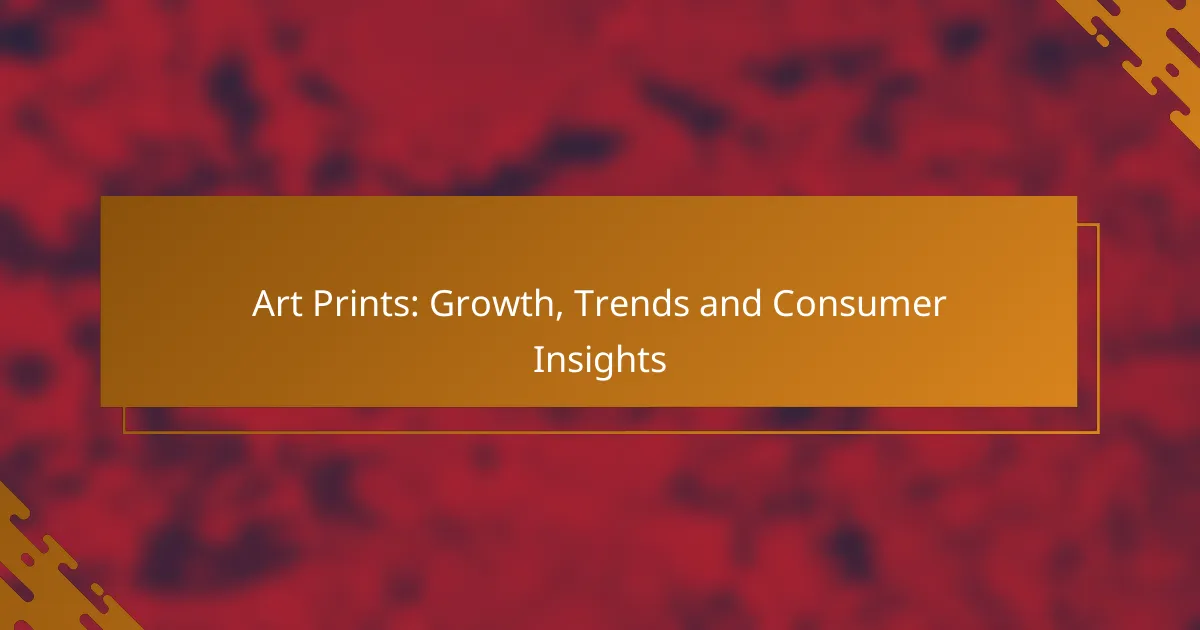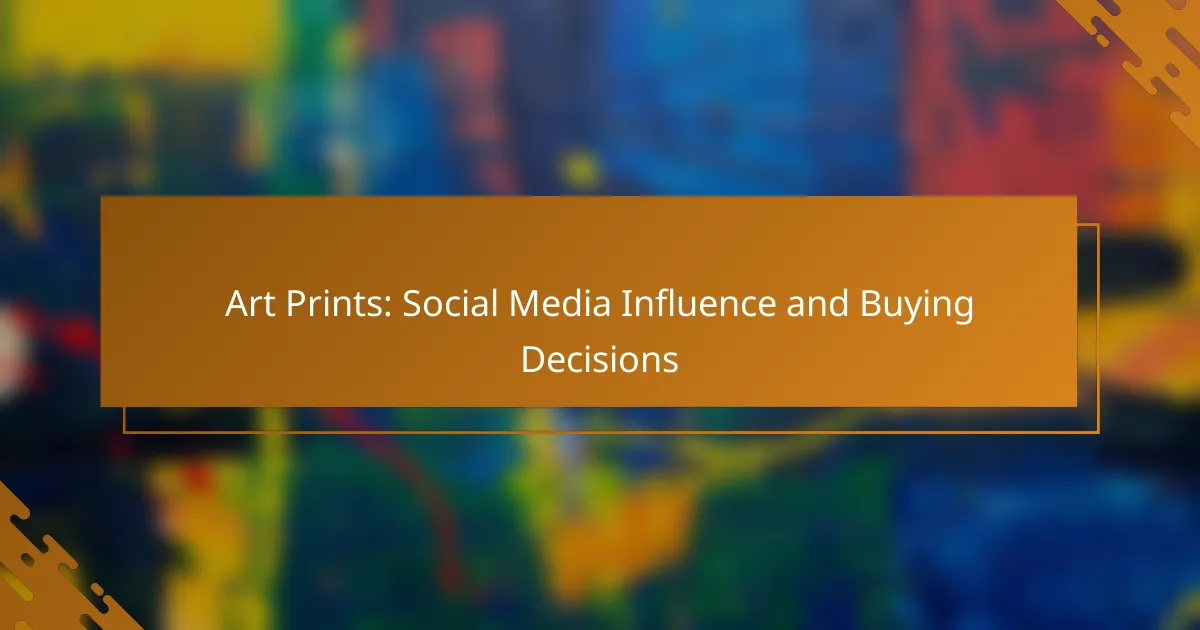The digital art print market is witnessing remarkable growth, fueled by trends that prioritize sustainability, exclusivity, and technological advancements. As consumers seek personalized and affordable options, the demand for eco-friendly materials and support for local artists continues to rise. This dynamic landscape is further enhanced by the proliferation of online sales and social media marketing, making digital art more accessible than ever.
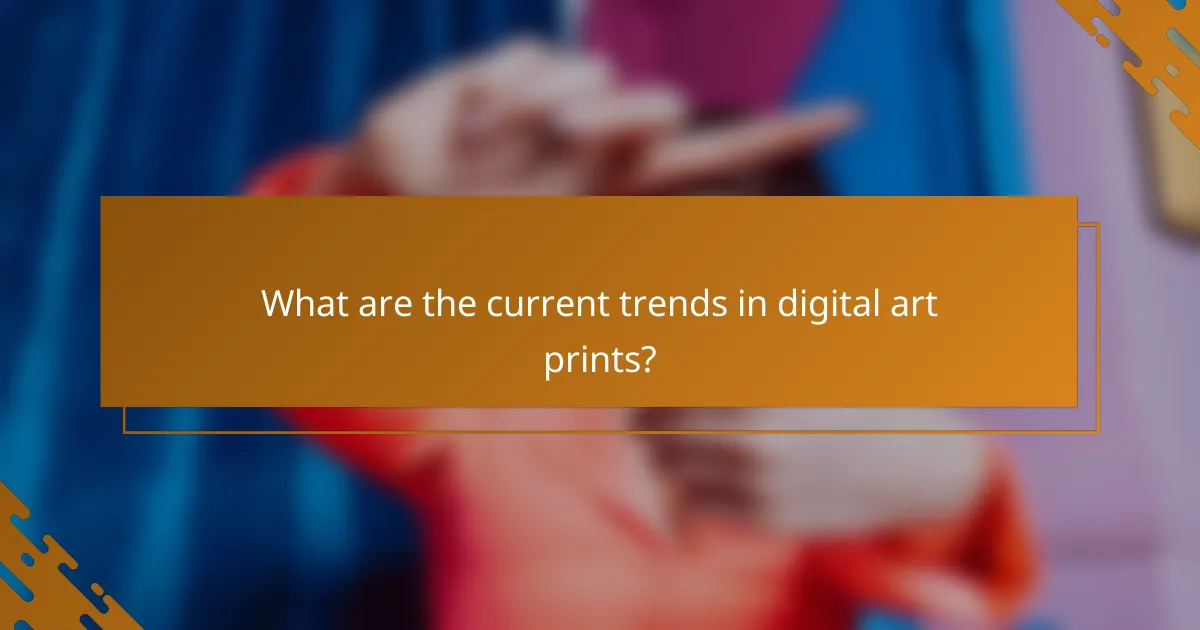
What are the current trends in digital art prints?
Current trends in digital art prints reflect a growing emphasis on sustainability, exclusivity, and technological integration. Artists and consumers alike are increasingly drawn to eco-friendly materials, limited editions, augmented reality features, and online marketplaces that enhance accessibility and visibility.
Increased use of eco-friendly materials
The shift towards eco-friendly materials in digital art prints is gaining momentum as artists seek to reduce their environmental impact. This includes using recycled paper, non-toxic inks, and sustainable printing processes. Consumers are becoming more conscious of their purchases, often opting for prints that align with their values of sustainability.
Artists can consider sourcing materials from certified suppliers to ensure their products meet eco-friendly standards. This not only appeals to environmentally aware buyers but can also enhance the artist’s brand image.
Popularity of limited edition prints
Limited edition prints are increasingly popular as they create a sense of exclusivity and urgency among buyers. Artists often release a small number of prints, which can drive up demand and perceived value. This trend is particularly appealing in the digital age, where mass production is common.
To capitalize on this trend, artists should clearly communicate the number of prints available and consider numbering and signing each piece. This practice can enhance the collectible nature of the artwork, making it more attractive to potential buyers.
Integration of augmented reality features
Augmented reality (AR) features are becoming a unique selling point for digital art prints, allowing viewers to experience art in interactive ways. By using AR technology, artists can create immersive experiences that bring their prints to life, adding layers of engagement.
Artists interested in incorporating AR should explore platforms that support this technology. Simple applications can include animations or additional content that viewers can access through their smartphones, enhancing the overall experience of the artwork.
Rise of online marketplaces for artists
The rise of online marketplaces has transformed how digital art prints are sold and distributed. Platforms like Etsy, Saatchi Art, and others provide artists with a global audience, making it easier to reach potential buyers without the need for traditional galleries.
Artists should take advantage of these platforms by optimizing their listings with high-quality images and detailed descriptions. Engaging with customers through social media and utilizing SEO strategies can further enhance visibility and sales in these competitive online spaces.
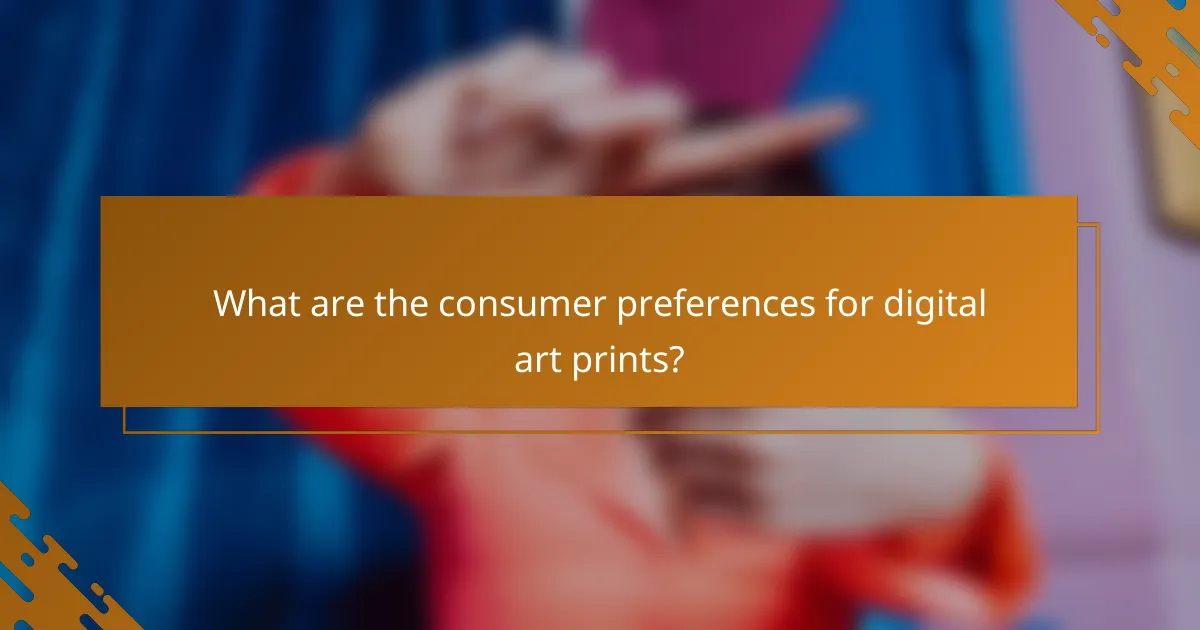
What are the consumer preferences for digital art prints?
Consumers increasingly prefer digital art prints that reflect their personal tastes and values. Key preferences include customization options, support for local artists, and affordability, which influence purchasing decisions in this growing market.
Preference for customizable designs
Many consumers seek digital art prints that can be tailored to their specific tastes. Customizable designs allow buyers to choose colors, sizes, and even themes that resonate with their individual style, making the artwork feel more personal and unique.
Offering customization options can enhance customer satisfaction and loyalty. Artists and sellers should consider providing tools for buyers to visualize changes before purchase, such as online previews or sample designs.
Interest in local artists’ work
There is a notable trend towards supporting local artists, as consumers often prefer to purchase art that reflects their community and culture. This preference not only fosters local talent but also creates a sense of connection and pride in the artwork.
Art marketplaces and platforms that highlight local creators can attract consumers looking for unique pieces. Collaborating with local artists for limited editions can also enhance appeal and exclusivity.
Demand for affordable pricing options
Affordability is a significant factor in consumer preferences for digital art prints. Many buyers are looking for quality art that fits within a reasonable budget, often seeking prints that are priced in the low double digits to low hundreds of USD.
Sellers should consider offering a range of price points and promotional discounts to cater to different budgets. Additionally, providing options for digital downloads can lower costs for consumers while still delivering quality art.
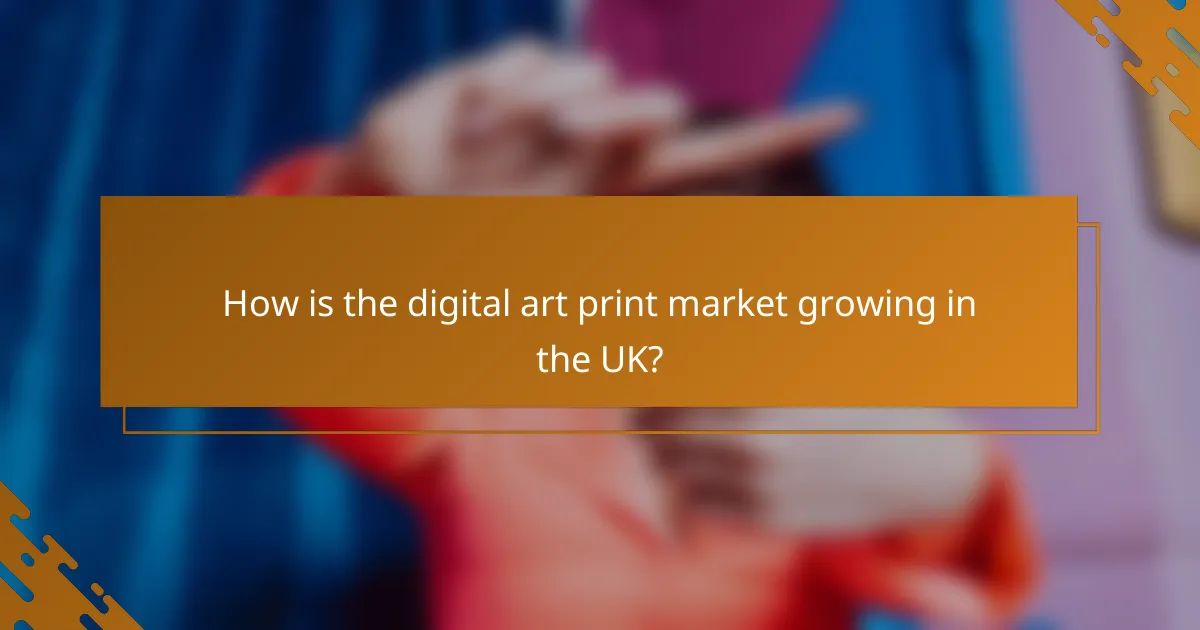
How is the digital art print market growing in the UK?
The digital art print market in the UK is experiencing significant growth, driven by increased online sales, social media marketing, and subscription services. This expansion reflects changing consumer preferences and the accessibility of digital art, making it a vibrant segment of the art industry.
Increase in online sales channels
The rise of e-commerce platforms has made it easier for artists and galleries to sell digital art prints directly to consumers. Websites like Etsy, Saatchi Art, and even personal artist websites are popular venues where buyers can browse and purchase art from the comfort of their homes.
Online sales channels often provide artists with a larger audience and reduced overhead costs compared to traditional galleries. This shift allows for competitive pricing, often in the range of £10 to £100 for prints, depending on the artist’s reputation and the print’s uniqueness.
Growth of social media marketing
Social media platforms, particularly Instagram and Pinterest, have become essential tools for promoting digital art prints. Artists use these platforms to showcase their work, engage with followers, and drive traffic to their online stores.
Effective social media marketing strategies include regular posting, using relevant hashtags, and collaborating with influencers. This approach can significantly increase visibility and sales, with many artists reporting a direct correlation between their social media engagement and print sales.
Expansion of subscription services
Subscription services for digital art prints are gaining traction, allowing consumers to receive new artwork regularly for a fixed monthly fee. This model appeals to art lovers who enjoy discovering fresh pieces without committing to large purchases.
Platforms like Art Crate and Society6 offer subscription options that cater to various tastes and budgets, often ranging from £15 to £50 per month. This growth in subscription services not only provides steady income for artists but also fosters a community of art enthusiasts who appreciate ongoing access to new works.
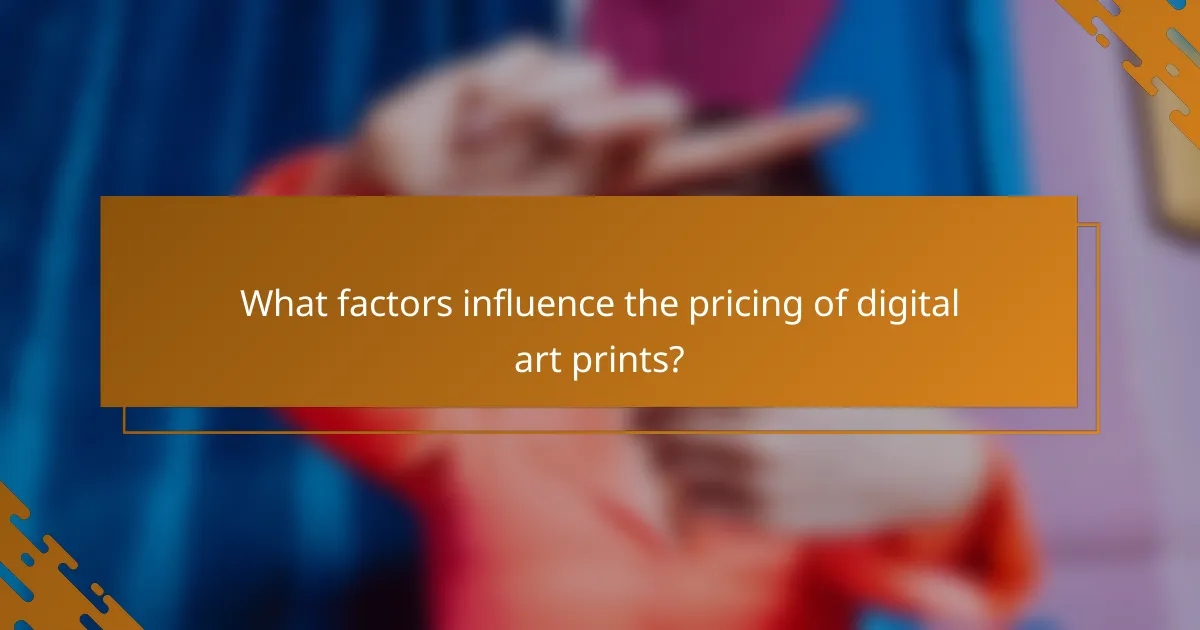
What factors influence the pricing of digital art prints?
The pricing of digital art prints is influenced by several key factors, including the artist’s reputation, the size and quality of the print, and current market demand. Understanding these elements can help both artists and buyers navigate pricing effectively.
Artist reputation and experience
The reputation and experience of an artist significantly affect the pricing of their digital art prints. Established artists with a strong portfolio and a following can command higher prices due to perceived value and demand.
Newer artists may need to price their work more competitively to attract buyers. Building a reputation over time through exhibitions, social media presence, and positive reviews can help increase pricing potential.
Print size and quality
The size and quality of a digital art print are critical factors in determining its price. Larger prints typically cost more due to increased material and production costs. High-quality prints, such as those using archival inks and premium paper, can also justify higher prices.
When pricing, consider the production costs associated with different sizes and materials. Offering a range of sizes can cater to various budgets, from affordable smaller prints to premium larger options.
Market demand and trends
Market demand and current trends play a vital role in the pricing of digital art prints. If a particular style or theme is trending, artists may be able to increase their prices due to heightened interest. Conversely, if demand wanes, prices may need to be adjusted downward.
Staying informed about market trends through art fairs, online platforms, and social media can help artists set competitive prices. Regularly assessing the market can also guide pricing strategies and promotional efforts.
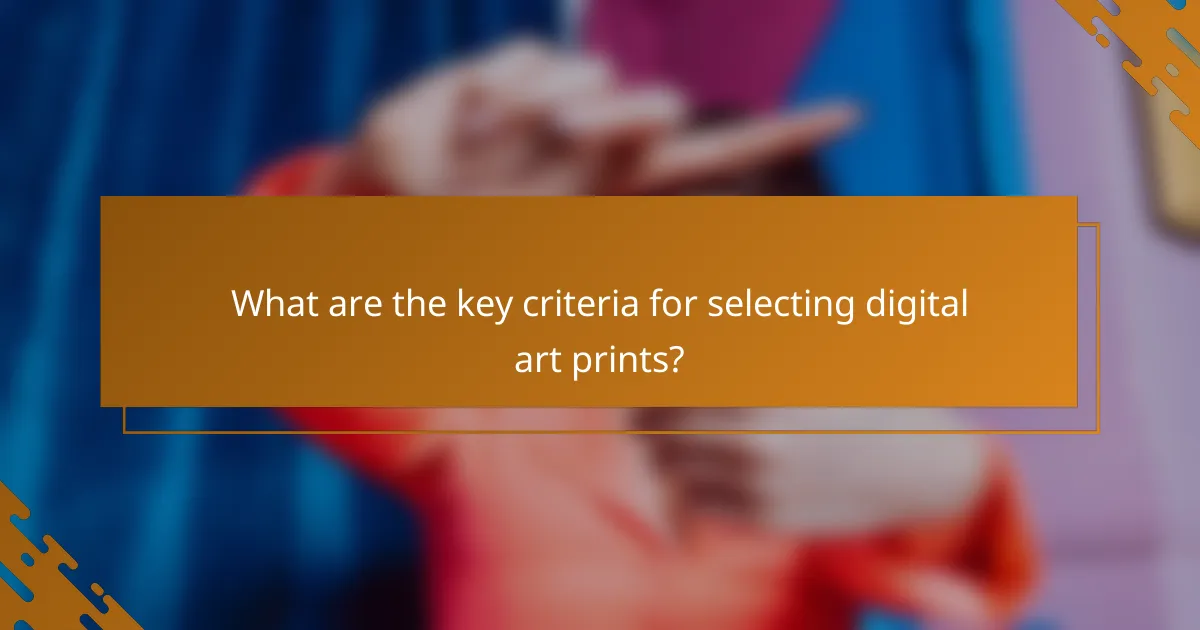
What are the key criteria for selecting digital art prints?
When selecting digital art prints, key criteria include artistic style, theme, print quality, and framing options. Understanding these factors helps buyers choose pieces that align with their personal taste and the intended space.
Artistic style and theme
Artistic style and theme are crucial in selecting digital art prints, as they reflect personal preferences and the atmosphere of the intended space. Popular styles include abstract, realism, and minimalism, while themes can range from nature to urban landscapes.
Consider how the chosen style and theme will complement existing decor. For example, a vibrant abstract piece may enhance a modern living room, while a serene landscape could suit a calming bedroom environment.
When browsing, look for prints that resonate emotionally and aesthetically. This connection can significantly enhance the enjoyment of the artwork over time.
Print quality and material
Print quality directly affects the visual impact and longevity of digital art prints. High-resolution images printed on quality materials, such as archival paper or canvas, ensure vibrant colors and sharp details.
Check for specifications like color accuracy and fade resistance. Prints made with pigment-based inks tend to last longer than those using dye-based inks, making them a better investment.
Additionally, consider the finish of the print. Options like matte or glossy can alter the artwork’s appearance and how it interacts with light.
Framing and display options
Framing and display options play a significant role in how digital art prints are perceived in a space. A well-chosen frame can enhance the artwork and integrate it into the decor seamlessly.
When selecting a frame, consider materials such as wood or metal, and styles that match your home’s aesthetic. For instance, a sleek black frame may suit contemporary art, while a rustic wooden frame could complement traditional pieces.
Additionally, think about the display location. Ensure that the print is hung at eye level and in a well-lit area to maximize its visual appeal.

